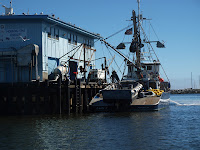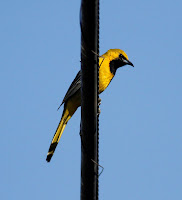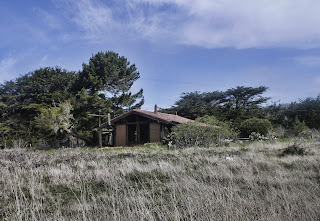Climate Change Deniers try very hard to spin scientific data in
such a way as to acquit mankind as being the cause of any
negative impact on this planet. We can eliminate the scientific
data and thus the spin by rearranging the terminology slightly
demoting Climate Change to a sub-set of Global
Destruction. In a past blog post
Global Destruction I outlined how the widespread
destruction of our planet is readily visible to anyone who cares
to look. I used a few examples, such as the 5 Ocean Gyres,
Mountaintop Removal and Coral Reef destruction. The photo on the
left is a graphic example of wildlife destruction directly
attributable to our careless disrespect for this planet and it's
inhabitants. Do we need some fancy scientific study to understand
this? I think anybody even young children gets what's going on
here! Chris Jordan did a photo essay titled Midway:
Message from the Gyre showing the results of Albatross ingesting
plastic at Midway Atol. He is currently working on a film of this
project and the trailer can be viewed at Midway Trailer.
Large corporations are taking engineering principles and
resources to scales that would boggle the mind just a few years
ago. Of major concern are the extents that energy companies are
resorting to squeeze the last remaining petroleum reserves out of
the bowels of our planet using extraction methods that threaten
the very existence of some of the last pristine areas on the
planet. There is no concern for depleting world resources at an
exponential rate but rather the attitude is, we can keep making
the same mistakes as always and just find faster and more extreme
methods of sucking the dregs of the fossil fuel reserves. Rather
than ask, what are we doing wrong, and how can we change and
correct the course we are on? It’s just easier to “keep on
keeping on” and patch it all up thru technology. This ensures there is no disruption
of the oil and the money that fattens the pockets of the greed
barons and the puppet politicians that green light any and all
absurdity. It seems that this kind of ignorance is not only born
out of greed but also the religious doctrine that teaches the
earth is just a temporary playground to be abused at will, and
mankind will be rewarded with a new hallucination complete with
pearly gates and unlimited voluptuous virgins with perpetually
spread legs!

|
|
Who's Watching Earth?
|
Representative John Shimkus of Illinois insists we shouldn't
concerned about the planet being destroyed because God promised
Noah it wouldn't happen again after the great flood. He made this
comment in March 2009 speaking before a House Energy Subcommittee
on Energy and Environment. Speaking of the Artic
National Wildlife Refuge (ANWR) Ted Stevens, former senator from
Alaska, held up a blank white sheet of paper equating that to
ANWR and calls the refuge "an empty, ugly place". Perhaps
it's time to require people seeking public office to pass some
kind of IQ test and demonstrate some rudimentary
understanding of science.
Geo Engineering:
Now a new battalion of John Henry Hammer Heads have joined the
mad fray under the delusion that the planet can be saved (and a
lot of money made) thru geo-engineering. Again, the attitude here
is screw fixing what’s broke, were so smart, nothing is
impossible to accomplish. This would not be so worrying
if these ego maniacs were just small fry bozos with no authority
to act. However big money brokers are hatching hair brained
schemes and convincing lots of folks of their sincere dedication
to saving the planet. When considering the large energy
companies, there is an illusion that they are somehow regulated
by governments and held responsible for their actions. Careful
analysis of the BP spill will totally debunk that notion. It
seems more likely the US Government agencies such as the EPA are
regulated by BP rather than the other way around.
So if the large energy companies operate more or less regulated
by themselves, what about the rogue geo-engineers? Russ George an
American businessman illegally dumped 100 tons of iron sulphate
into the Pacific Ocean off of British Columbia in 2012. The
result was the formation of a 10000 square kilometer artificial
plankton bloom visible from satellite as high concentrations of
chlorophyll. The intent termed ocean fertilization is for the
plankton to absorb carbon dioxide and sink to the ocean bed. Hey
people these are our oceans, how dare some reckless megalomaniac
pull off dangerous experiments as if he alone owns the ocean. Is
this just the beginning of eco terrorist geo-engineers joining
forces with the already out of control and unregulated energy
companies in a mad dash to speed the demise of the human race?
It’s surmised that 98% of all species that have ever existed are
now extinct. I’m sure mankind is the only species ever that has
worked intentionally and unflinchingly to join that
list!
Is There Any Hope?
Although I’m pessimistic about the human race rescuing itself
considering the destructive behavior that has gone unchecked
for years. The question is what can be done right now to quell
the on-going damage and perhaps start to reverse this spiral to
oblivion! In 1969 the United States successfully landed people
on the Moon. This triumph culminated in an unprecedented
National effort to do the impossible. It took a National
commitment, a ton of money, the will of the people and many
hard years of work to reach the goal. We need a new commitment,
a new goal, not a National goal but a World Wide goal as we are
in a World Wide crisis. We currently have 5 ocean gyres or
garbage patches in our oceans, 2 in the pacific, 2 in the
Atlantic and 1 in the Indian Ocean. The Patch is characterized
by exceptionally high concentrations of pelagic plastics,
chemical sludge, and other man made debris. This is imposing a
massive infection of the oceans and all supporting
life. These gyres
are physical, they have size and depth, and content. They need
to be gone! The gyres are but one large assault on our oceans
and our planet. If we are to survive as a species the major
environmental damages need to be addressed now. Let’s see what
an effort to clean up the gyres might look like.
Gyre Removal
Project:
No study to my knowledge has been done to address the clean-up
of the garbage patches at this time. So I’ll taking a wild
first swing at what such a project would look like considering
all of the pre-project studies have not yet been done or even
fanaticized about yet. My projection is based on my engineering
experience and the belief that any dream that can be conceived,
given enough resources and money can be created and brought
into existence. Using engineering for good, not destruction,
instead of trying to counter the destruction as some insane
mindless flailing geo-engineering this approach say let’s fix
what we broke and return it to its pristine original before man
condition.
It’s important to set a date to accomplish this goal, let’s
start by setting 10 years as the target time.
This needs to be a World Wide effort with as many countries
as possible participating and sharing the weight of this
endeavor. Every country should have an equivalent department like
the US’s NASA and all these worldwide organizations would be
organized into an efficient, effective, long term entity to clean
the oceans, both of garbage and acidification!
More than likely the ocean clean-up project will be the most
ambitious, costly, complicated and far reaching engineering
endeavor ever accomplished by human-kind! I can envision the
largest floating vacuum cleaning type vessels ever conceived
sucking debris from the gyres, separating and isolating the
plastic particulate to be recycled into green beneficial
products. Then again it may look totally different but whatever
is necessary to disappear the gyres needs to be fast-tracked now!
It’s encouraging to see grocery store shoppers finally stripped
of plastic bags and now outfitted with re-usable bags. It took
the people of the state of California for example to ban plastic
bags in places such as San Francisco, San Mateo County and San
Jose. I wonder about the integrity of such corporation such as
Safeway that waited for a law to ban plastic bags, rather than
take the initiative themselves and had the bags banned years ago.
At any rate it is the small steps such as these where we as a
people can make green progress on an individual basis. To
effectively clean-up the ocean we need to stop adding material to
the garbage pile, so plastic bag bans are a step in the right
direction! A recent
study just concluded after 22 years by Monterey Bay Aquarium
Research Institute (MBARI) found prodigious amounts of plastic
debris and other debris in the Monterey Canyon. Fifty percent of
the garbage found consisted of plastic bags. I would bet most of
them are from the large chain retail outlets found all over the
world.
It's time we question our own apathy and put the brakes on
corporations and individuals driven by insatiable greed on a
collision course to earths destruction and the elimination of
life on this planet.
Who owns this planet? Nobody owns earth, we are caretakers
entrusted to protect our planet for future generations of all
life forms.





















